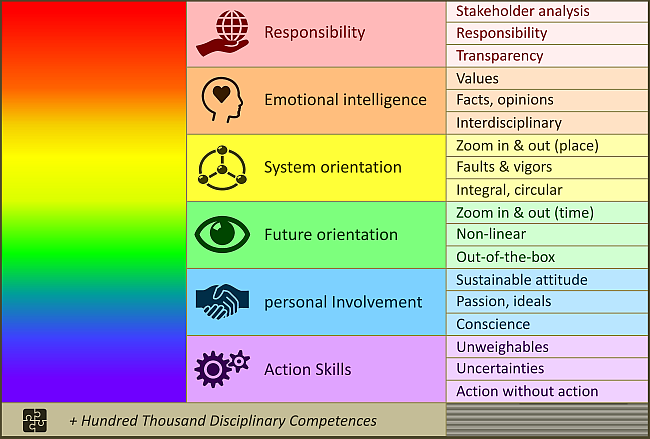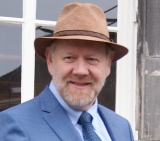RESFIA+D: Spectral Completeness |
An interesting question is: Is the set of RESFIA+D's sustainability competences complete?
To be honest: the '+D' part, the disciplinary competences, can never be complete. There is an unlimited range of disciplines, industries, professions, and positions. Symbolically speaking, there are a 'hundred thousand' disciplinary competences.
> One fascinating example of a disciplinary competence is described on the next page.
How about the 'RESFIA' part, the general competences? Of course, there are many ways to define competences, as the webpage about the theoretical backgrounds of RESFIA+D discusses. Surely there will be people – you may be one of them – who will mention a competence missing from the set. How about: ethical consciousness, inspiration, leadership, or stewardship?

The Spectrum of the Six General Competences
Splitting the Spectrum
Competences are like colors; there are an infinite number of them. If you mentioned a long series of colors and then claimed you had listed all of them, it would not be very hard to point out shades you had missed. There would be every chance that you didn’t include Bulgarian rose, Vegas gold, or Harvard crimson. Mint, eggplant, or vanilla. Perhaps, you failed to mention a nameless color that is indicated by its RGB values (red-green-blue), each expressed as a number between 0 and 65,535: This offers a variation of more than 280 million shades. That’s a lot, but it is nothing compared to the infinity of all colors. No, an enumeration of colors can never be complete.
The same applies to competences for sustainability. Whoever wants to, will be able to express hundreds of them in the English language, and if you think that is still not enough, you can make up your own new words or borrow them from other languages. In short, the quest for completion is at best a hopeless effort and at worst a desperate exercise.
A Variety of cultures
To deal with the enormous variety of colors, people have chosen to give names to a limited number of main colors and to consider the rest as mixtures, blends, or combinations of them. Since this has been done independently throughout many eras and in different cultures, it has rendered a fascinating diversity.
Western culture traditionally distinguishes seven colors of the rainbow, plus black and white. In total, this makes a set of nine:
• Red, orange, yellow, green, blue, indigo, violet, black, white
However, the Candoshi, a Peruvian tribe, distinguish only eight basic colors:
• Chobiapi, ptsiyaro, kamachpa, kavabana, tarika, kantsirpi, ponzani, borshi
It is not easy to translate them into English, but if you try, you get something like: red, yellow, bright green, greenish blue, purple, black, pale & grey, white.
The Kwerba, a tribe in Irian Jaya, Indonesia, know even fewer, namely four colors:
• Asiram, nokonum, kainanesesenum, icem
In English, this is roughly equal to red, yellow, green & blue & black, white.
You may be thinking: That’s rather primitive; only four colors?
Well, a hypermodern laser printer does not possess many more, as it is usually a five-color printer:
• Magenta, yellow, cyan, black, white
For four of those colors, the printer has separate toner cassettes. The fifth color, white, is produced cleverly by not using each of those four toners simultaneously. How could the Kwerba be primitive? They are hardly second to a printer from the 21st century.
The need to split
Why are there such huge differences between color schemes? Because every scheme you design will always be a simplification of reality. What you do is: you cut a continuous color spectrum into a finite set of separate colors. Actually, this is simply wrong, but what are you going to do? If you don’t wish to make this mistake, you can never define a color. And so we cut the rainbow into pieces: nine in Europe and North America (if you include black and white), eight with the Candoshi, four with the Kwerba, and all kinds of other numbers within hundreds of different cultures.
This dividing of a continuous spectrum into a finite set of separate elements is something we do all the time, in every area. Do you want some examples from management science?
| 9 is the number of criteria of the EFQM Excellence Model for quality management: • Leadership, strategy, people, … 8 is the number of fields in Leary’s Rose: • Leading, helping, co-operative, … 7 habits are what highly effective people possess, according to Stephen Covey: • Proactive, begin with the end in mind, first things first, … 6 M’s are basic to the Six Sigma method for quality management: • Machines, methods, materials, … 5 layers together form the hierarchy of Maslow's pyramid, the famous model for the needs and motivations of people: • Physiological needs, safety, social needs, … 4 steps are what Deming’s PDCA, the well-known control cycle, consists of: • Plan, do, check, act 3 is the number of elements in the Triple P of sustainable development: • People, planet, profit 2 basic principles exist according to traditional Chinese philosophy: • Yang, yin 1 is the number of universes we live in: • Reality |
|
A cover
Mathematicians speak of a “cover.” The nine criteria of the EFQM model “cover” the wide area of quality management, roughly equal to the way in which a window screen covers an open window: hermetically closed for mosquitoes and other bugs and thus effective; but not 100% closed, therefore allowing fresh air to enter.
In the same way, the six-fold RESFIA set of competences covers the wide range of competences of a sustainable professional. Its spectrum includes, as the above figure illustrates:
• Responsibility, emotional intelligence, systems orientation…
This is not airtight; but it is effective. If you mention competences that are not literally there, they probably present variations or combinations of RESFIA competences. Here are a few examples:
• Are you looking for ethical awareness? Go to Conscience, one of the achievement of competence I: personal Involvement.
• Do you want to find inspiration? Have a look at Passion, dreams and ideals, also a part of personal Involvement.
• Aside from that, turn to Innovative, creative, out of the box, an aspect of competence F: Future orientation.
• You are interested in stewardship? Search for competence R: Responsibility.
• Concerning leadership: This is a concept of a different nature, not so much a competence but rather an aspect of a
competence level: see this page, where varying degrees of leadership are explained, ranging from Apprentice
(developing) to Master (highly advanced).
All in all, this means that the “rainbow” of sustainability competences is complete, not in the sense of “airtight,” but certainly in the sense of a “cover.” RESFIA+D is not perfect; but is is sufficient and applicable.
Nevertheless, it is conceivable that some essential competences for sustainability are truly missing from the RESFIA+D framework. If you think you can argue that this is the case, please feel free to contact Niko Roorda, the designer of RESFIA+D.

